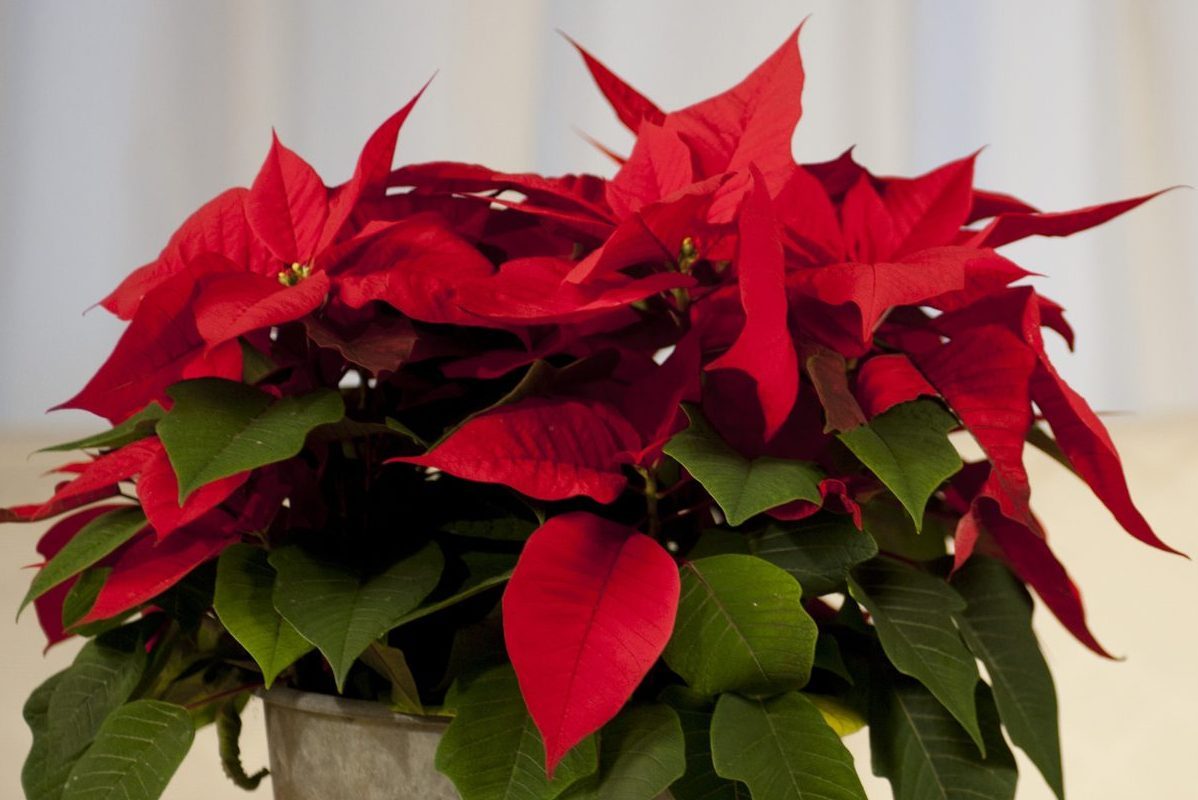A good day to buy a poinsettia is on National Poinsettia Day, December 12th. Then enjoy it all year as a great houseplant.

How To Keep a Poinsettia Alive After Christmas

What is the top-selling plant in the world? According to Lisa Eldred Steinkopf, author of Bloom: The Secrets of Growing Flowering Houseplants Year-Round, it’s the poinsettia. Amazingly, nearly 70 million poinsettias are sold each year, mostly from mid-November right up until Christmas.
The poinsettia (aka Cuetlaxochitl) is so popular that National Poinsettia Day, December 12th, was established in 2002.
On This Page
How To Care for a Poinsettia
Poinsettias are easy, undemanding houseplants to care for. They are originally from Mexico, where they never get cold and occasionally dry out. Before Christmas, they’re a much loved holiday decoration. After Christmas, they become a houseplant you can enjoy for years if you wish.
Poinsettia care before Christmas
To maximize the enjoyment from a poinsettia before Christmas, keep the following tips in mind:
- Look for poinsettias with a nice, tiny yellow flower in the center that’s just opening. Also check lower leaves, which may be hiding under a foil pot cover. Pass on those with drying or yellow leaves.
- Keep your poinsettia out of the cold. Poinsettias grow best at temperatures above 65 degrees, and can suffer damage below 50 degrees. Buy your poinsettia on a warmer day or wrap it loosely when you make a mad dash to your vehicle.
- Avoid letting your poinsettia sit in standing water. The foil pot liner is a great decoration but can hold water and keep the poinsettia too wet. Remove it when you water, then let the water drain from the pot before putting the foil back on. Only water when the soil feels dry.
- Place your poinsettia away from cold drafts, the fireplace or a heat vent. Then enjoy it through Christmas.
Poinsettia care after Christmas
After Christmas, it’s tempting to toss out a poinsettia. But it’s also fun to keep it growing as a houseplant.
- Move the poinsettia to a spot where it will get natural light but still be protected from drafts and drying heat.
- Water when dry.
- Mist occasionally to increase humidity around the plant.
- Watch for spider mites, which can become a problem in dry, indoor environments. If you see webbing, a sign of spider mites, wash the plant thoroughly and increase the humidity level around the plant.
- Once the blooms fade, cut the plant back to about eight inches. It will look stubby but soon will grow new leaves and bush out again.
- In spring, repot your poinsettia into a more substantial container than the plastic one it came in. Choose one to two inches wider than the original container.
Use Poinsettia as an Outdoor Filler Plant
A poinsettia in the summertime may look out of place to some. But after the colorful bracts (leaves) are gone, it’s a simply a nice, green plant.
You can put it outside once nighttime temperatures are consistently above 60 degrees. Keep it in its own container, which will help it bloom again, or use it to fill out other containers of flowering plants.
Be sure to take it back inside well before nighttime temperatures begin to drop in late summer. Or, if you live in U.S. Department of Agriculture Plant Hardiness Zones 11 through 13, you can plant it in the ground to grow year-round.
Get Your Poinsettia to Rebloom
Poinsettias set flower buds in response to shorter days. They need complete darkness for 14 hours a day for 10 to 12 weeks to bloom again.
Beginning in mid-September to early October, you can provide this darkness by consistently covering the poinsettia with a large box or by moving it to a dark location at the same time each night. Then 14 hours later, move the poinsettia where it will get good natural light.
The key is to be consistent. Missing even one or two nights of darkness can keep a poinsettia from blooming.
Are Poinsettias Poisonous?
Poison Control says poinsettias are not deadly, even if eaten.
“In most cases, exposure to any parts of the poinsettia plant in children or pets has very little if any effect,” according to an article on the Poison Control web site. “If swallowed, it may cause mild irritation: nausea, vomiting or diarrhea.
“Touching it may cause a rash. There have been reports of gardeners who work with the plant frequently developing a rash from handling the plant.”




















